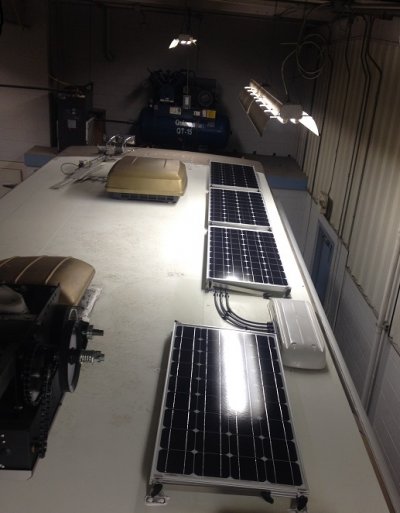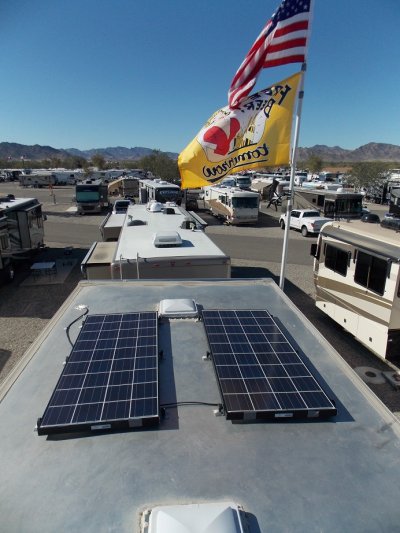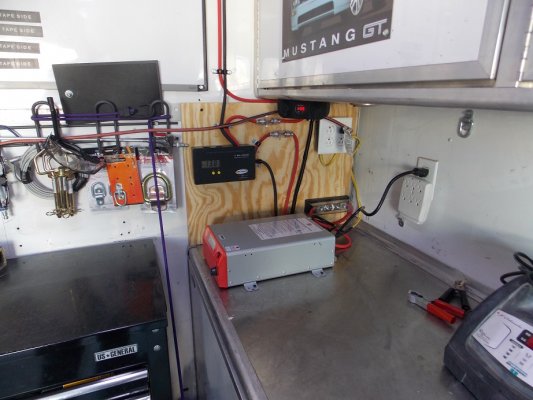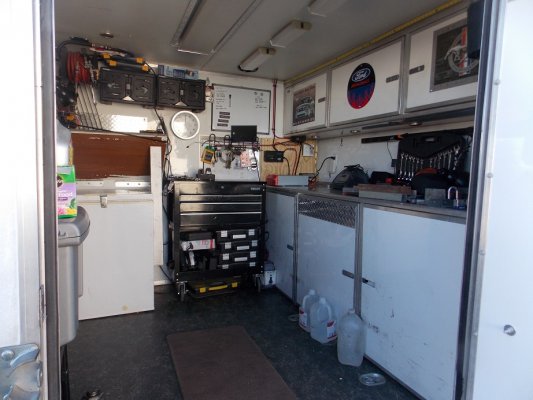HueyPilotVN
Well-known member
I just spent most of the afternoon at Discount Solar in Quartzsite going over the speciifications and designing and picking up all the components for two seperate Solar Systems.
One is for the Stacker and the other is for the Country Coach DP.
The Stacker system is for providing power to do three things. First it provides power thru an invertor to make sure that the freezer in the Stacker always has power. The second use it to allow me to charge the batteries in the golf cart. The third use is for general A/C power for power tools in the workshop.
I am going to mount the panels on the roof of the Stacker flat without tilting mounts because the roof is over 13 feet 6 inches high already and I do not want to climb on that rood anyway.
The combiner will mount high up on the inside wall feeding 6 guage cable down to the Charge Controller that will mount just above the workbench on the wall also.
The output from the controller will go thru short 6 guage cable to a large fuze then to the Optima blue top batteries located under the workbench.
The Invertor will mount in the same location above and at the end of the workbench. It is fed from the batteries with short 6 guage cable going first thru a 200 Amp Fuze. The Invertor will feed A/C to the freezer at all times. The invertor will be powered by A/C if the Stacker is plugged in or by the DC batteries if no shorepower is available. The Invertor will also charge the batteries if on shorepower. This will insure that the freezer will stay cold even when driving down the road or when boondocking.
The system for the DP is simpler. It is virtually the same system as the Stacker except I already have the Xantrex 3000 watt invertor that is fed by 6 Trojan T-105 batteries thru a large fuze.
All I am doing is adding the Solar charging half of the system. I will use tilt mounts on the panels on the DP roof because it is lower and easier to get to on the roof. The cable will feed down the refridgerator vent using a combiner at the top to connect the smaller wires of the panels to the same type 6 guage cable as I am using in the Stacker. These two 6 gauge cables run down to the battery compartment that is lower and next to the Refer. I am mounting the Charge Controller in the compartment next to and seperated from the battery bank and then feeding the batteries thru another fuze. Many people mount the Charge controller inside the Coach where it is available and visable. In my case I already have the remote Xantrex panel mounted on the wall inside and it shows the battery state of charge already.
My next step is to find an able bodied person or two to hire for the install. I want to supervise and manage the install to both make sure it is done exactly as I want and to be able to modify it at any step in the process. When you do it this way you can catch anything that you want to be changed and do it in the best possible way. I know that the installers are good at Discount Solar, but I would drive then crazy if they would even let me near during the install. So I did not even ask.
Film at eleven.
One is for the Stacker and the other is for the Country Coach DP.
The Stacker system is for providing power to do three things. First it provides power thru an invertor to make sure that the freezer in the Stacker always has power. The second use it to allow me to charge the batteries in the golf cart. The third use is for general A/C power for power tools in the workshop.
I am going to mount the panels on the roof of the Stacker flat without tilting mounts because the roof is over 13 feet 6 inches high already and I do not want to climb on that rood anyway.
The combiner will mount high up on the inside wall feeding 6 guage cable down to the Charge Controller that will mount just above the workbench on the wall also.
The output from the controller will go thru short 6 guage cable to a large fuze then to the Optima blue top batteries located under the workbench.
The Invertor will mount in the same location above and at the end of the workbench. It is fed from the batteries with short 6 guage cable going first thru a 200 Amp Fuze. The Invertor will feed A/C to the freezer at all times. The invertor will be powered by A/C if the Stacker is plugged in or by the DC batteries if no shorepower is available. The Invertor will also charge the batteries if on shorepower. This will insure that the freezer will stay cold even when driving down the road or when boondocking.
The system for the DP is simpler. It is virtually the same system as the Stacker except I already have the Xantrex 3000 watt invertor that is fed by 6 Trojan T-105 batteries thru a large fuze.
All I am doing is adding the Solar charging half of the system. I will use tilt mounts on the panels on the DP roof because it is lower and easier to get to on the roof. The cable will feed down the refridgerator vent using a combiner at the top to connect the smaller wires of the panels to the same type 6 guage cable as I am using in the Stacker. These two 6 gauge cables run down to the battery compartment that is lower and next to the Refer. I am mounting the Charge Controller in the compartment next to and seperated from the battery bank and then feeding the batteries thru another fuze. Many people mount the Charge controller inside the Coach where it is available and visable. In my case I already have the remote Xantrex panel mounted on the wall inside and it shows the battery state of charge already.
My next step is to find an able bodied person or two to hire for the install. I want to supervise and manage the install to both make sure it is done exactly as I want and to be able to modify it at any step in the process. When you do it this way you can catch anything that you want to be changed and do it in the best possible way. I know that the installers are good at Discount Solar, but I would drive then crazy if they would even let me near during the install. So I did not even ask.
Film at eleven.




